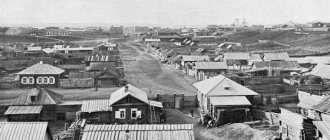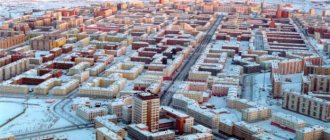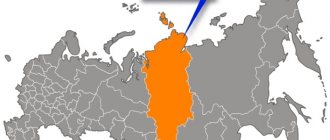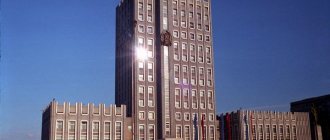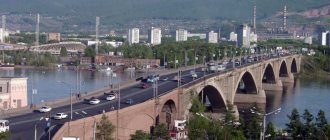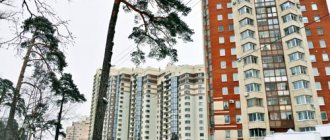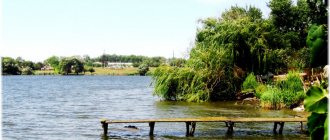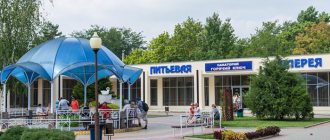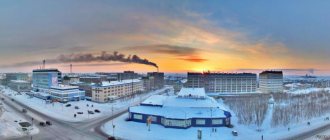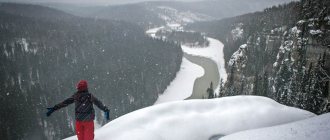Historical notes
Zelenogorsk owes its appearance to the need to build an electrochemical plant for the production of highly enriched uranium. In 1955, construction of a city began near the territory of the future plant. Before this, there were only two settlements here: Ilyinka and Ust-Barga. In November 1955, military builders arrived here and began setting up a tent city in the cold.
The first stone of the city was laid in a solemn ceremony on July 18, 1956. This date is considered the city's birthday. At first, houses were built from wood; the first stone building was a school.
In the early 60s, the construction of two important facilities was completed - the plant and State District Power Plant-2. In 1963, the new settlement received official city status. After this, cultural leisure facilities for the townspeople began to be actively built: a two-hall cinema, a palace of culture, a cafe, a hotel. In subsequent decades, the city actively developed and grew.
In 1980, it was put into operation, which supplied high-quality viscose fiber not only to the USSR, but also to foreign countries. The electrochemical plant was eventually repurposed to produce civilian products. This made it possible to cooperate with foreign partners.
In the early 90s, large enterprises began to experience financial difficulties, but private business began to develop.
Zelenogorsk. Embankment
Links[edit]
Notes[edit]
- ^ abcde Law No. 10-4765
- ^ a b Federal State Statistics Service (2011). “All-Russian Population Census 2010. Volume 1" [All-Russian Population Census 2010, vol. 1]. All-Russian Population Census 2010 [All-Russian Population Census 2010]
. Federal State Statistics Service. - "26. The size of the permanent population of the Russian Federation by municipalities as of January 1, 2022". Federal State Statistics Service. Retrieved January 23, 2022.
- ^ abc Law No. 14-3412
- "On the Calculation of Time". Official Internet portal of legal information
. June 3, 2011. Retrieved January 19, 2022. - Post office. Information and computing center of OASU RPO. ( Post office
).
Search for postal service objects ( postal Search for objects
) (in Russian) - ↑
Federal State Statistics Service of Russia (May 21, 2004).
“The population of Russia, the constituent entities of the Russian Federation as part of federal districts, urban settlements, settlements, settlements of 3 thousand or more people” [Population of Russia, its federal districts, federal districts, districts, urban settlements, rural settlements - administrative centers and rural settlements with a population of more than 3,000 people] (XLS). All-Russian Population Census 2002
.
How to get there
You can get to Zelenogorsk from Krasnoyarsk by car or bus. The length of the route will be 156 km. On the way you will come across only one city - Uyar. Buses depart from the railway station. train station and bus stations of the city. By transport you can get from Krasnoyarsk to Zelenogorsk in 3 hours 40 minutes. Ticket price – from 400 rubles.
You cannot get to Zelenogorsk by train. However, the railway line passes through the neighboring town of Zaozerny. You can get from Krasnoyarsk to Zaozerny station, and from there take a taxi or a regular bus to Zelenogorsk.
"Shogun" and "Zelenogorsk OPT"
In case you get hungry, on the right side of the Palace of Culture there is a restaurant called “Shogun” on Mira, 15. It is also a kind of landmark - just as Irkutsk is proud of its “Harats pubs”, the network of which has expanded far beyond the borders of Irkutsk, so Zelenogorsk could be proud with its “Shogun”, establishments have already opened in five cities. The rolls, noodles and everything else here are quite good.
We go further along Mira Street - to a shop with the unremarkable name “Zelenogorsk OPT” (Mira, 42). Here, the guys sell a local miracle - the famous Zelenogorsk bottled beer. In Krasnoyarsk bars they won’t serve you this, it’s not “Zelenogorskoye Razlivnoe”, but just one name. You need to drink it here, where it is freshest. (Or not to drink: alcohol is contraindicated for people with ulcers, teetotalers, pregnant women, young people, old people, and also all media that are prohibited from advertising it. So just look at the legendary bottle, spit - and move on at a sporty pace - editor's note)
Opposite the store are blocks of wooden houses. They were built in the 50s, and, like almost everything in Zelenogorsk, they carefully conveyed the spirit of the time to the present day. In any courtyard you can sit down on a free bench and drink something you’ve just purchased (but you’re not like that - editor’s note). Patrols in peaceful Zelenogorsk are very rare, so only some local grandmother could reprimand you for drinking. Don’t offend your grandmother, Komsomol members, there are many courtyards, there are benches in each one, old people are honored everywhere (but drinking is harmful - editor’s note).
Temple of St. Seraphim of Sarov
The construction of the Cathedral of Seraphim of Sarov began in Zelenogorsk in 1996 and ended in 2003. Its height was 35 m. The temple is distinguished by its multi-colored decoration and golden domes. The area surrounding the church is well landscaped.
Temple of St. Seraphim of Sarov
The temple contains shrines: the relics of Seraphim of Sarov, Nicholas the Wonderworker and Alexander Nevsky.
Currently, work is underway to equip the church. Artists are painting the inside of the cathedral.
Address : st. Parkovaya, 3a.
Rock club "Reanimation"
The rock club (Komsomolskaya, 17) is legendary, its founding father says that it unofficially appeared already in 1990, and the premises in the basement of the Palace of Pioneers opened the doors to long-haired visitors 16 years ago. Every year, the club’s team hosts the “Citadel” festival in Zelenogorsk, where rock musicians, bikers, role-players and other old school people come from different cities. You will only be shown so many colorful characters in leather jackets with stripes at “Invasion”. “Resuscitation” is highly recommended, especially if you haven’t shouted “ROOOK!” to the group for a long time. from the dance floor, didn’t dance to “Metallica”, didn’t end the evening dancing to “KiSha”.
Opposite the entrance to the Palace of Children's Creativity, turn 180 degrees and go down to the main square of the city (Mira St., 15). The administration, the monument to Lenin, the Cosmos Hotel, the Palace of Culture named after the Lenin Komsomol - with a preserved inscription on the facade and a winter garden on the second floor - welcome you.
City fountains
There are five fountains in Zelenogorsk. The most favorite among the townspeople is the “Yenisei and Kan” building. In the summer, children play in it, pouring water on each other, while adults enjoy the music of a brass band.
The illuminated fountain located near the Barga River is popular with newlyweds. There is a tradition on the wedding day to come to the building, close the lock, and throw the key into the water.
Fountain "Yenisei and Kan"
Museum of Military Glory
This museum will really appeal to all male representatives. Here, in the open air, there is a collection of military equipment: tanks, guns, planes, missiles, etc.
The Museum of Military Glory organizes patriotic education for children. On its territory, police and soldiers take the oath. The guides talk about historical events.
The staff also organizes thematic exhibitions, lectures and excursions. Throughout the year, the museum broadcasts war films, gathers participants in combat operations, and conducts general educational programs, for example, “Military-Historical Reconstruction Club” and “Do-It-Yourself Museum.”
Museum of Military Glory
Address : st. Stroiteley, 12. Opening hours : Mon-Fri - 9.00-18.00.
Library named after V.V. Mayakovsky
Library named after V.V. Mayakovsky, in addition to the main division, has 4 branches offering high-level service.
The library opened in 1959 and was the first in the city. In 1965, the institution was named after A.P. Chekhov. Two years later, the library moved to a new building, where it remains to this day. At the same time, by decision of the executive committee, the institution was named after V.V. Mayakovsky.
In 1996, a collection of miniature and microminiature books began to form. He has currently accumulated about 1,000 copies.
In 2000, the library of V.V. Mayakovsky entered the top ten best similar budgetary institutions in Russia.
In 2004, a program to modernize automated library systems was organized. The library has repeatedly participated in various government programs and received awards in various competitions.
Currently, the institution is working on creating an electronic catalog and fund files. There is an information and bibliographic department where you can use electronic databases.
Library named after V.V. Mayakovsky
The institution serves both adults and children. It is constantly searching for new forms of service. For example, branch No. 1 acts as a library-museum. The institution operates an intellectual casino, family reading programs, and services for the visually impaired.
Address : st. Bortnikova, 3.
Zelenogorsk (aka Terijoki)
10/22/2020 Natalia Kutenina Russia, Russia and CIS, Countries
Comments:
Strange summer 2020...
We will remember this year for a long time... Leap year, 2020... And what a beautiful number - twenty-twenty! No one could have imagined that in 2022 the whole world would be turned upside down.
Even in winter, many went on vacation - some to the sea, some to the mountains. Back in late February and early March, Muscovites went to theaters and concerts, to restaurants and on visits. And all of this stopped at once. Theaters and concert halls, cafes and restaurants were closed. Pensioners were forbidden to leave their homes and their social cards were blocked. And then the rest of the residents stopped working. In general, the further it goes, the more fantastic it becomes.
But I wanted to tell you a little about something else. Many planned to go on vacation in the spring or summer, bask on the hot sand by the warm sea. But they closed the borders between countries and even between regions of Russia. It was impossible to fly or leave anywhere. Dreams and trips began to burn with a blue flame - tours that had already been paid for were canceled, and the money for them was not returned. This is the situation I found myself in - I was planning to go with my daughter and her husband in June with an early booking for two weeks to Bulgaria and for a long time hoped that everything would resolve by summer. It didn't resolve. Only by mid-summer did it become possible to replace the tour - Russian resorts opened. But I didn’t want to go to our south at all, and the choice was limited by the offers of our tour operator. And then on his website we found a suitable option - the Northern Riviera sanatorium near St. Petersburg, on the shores of the Gulf of Finland, not far from the city of Zelenogorsk. We knew these places well - we had vacationed in Zelenogorsk many times before. And we decided to take a risk. After reading reviews about the sanatorium, we learned that there is a cottage village called “Yantarny” on its territory. We rebooked a trip from Bulgaria to St. Petersburg - and our vacation began in August!
History of Zelenogorsk
Before sharing your impressions of your August holiday, you must definitely talk about Zelenogorsk. He has many guises. This is a city in Russia, and an intra-city municipal formation as part of the Kurortny district of St. Petersburg, and a climatic resort on the northern shore of the Gulf of Finland of the Baltic Sea. The Zelenogorsk railway station is located on the 50th kilometer of the St. Petersburg (Finlyandsky Station) - Vyborg line.
The railway station (1917, architect Bruno Granholm, rebuilt in 1950, architect A. A. Grechannikov) is a stone building in the style of national romanticism. Zelenogorsk is also an old Finnish city, which until 1948 was called Terijoki.
A little history. The small fishing village of Terijoki (Resin River) at the confluence of the Pearl Stream into the Gulf of Finland dates back to the 16th century, when it still belonged to Sweden. Thanks to the Gulf of Finland, which was the “breadwinner” of local residents for several centuries, Terijoki first appeared on the tablets of history. In 1548, the Swedish king Gustav Vasa issued a decree on the execution of several Karelian peasants who were engaged in smuggling trade with the Hanseatic cities. Among those sentenced was a certain Antti from Terijoki. This is the first mention in official documents and is considered the starting date of the village’s existence. One of the streets in Terijoki was even later named after Antti. The topic of smuggling in these places was clearly relevant until the 19th century; it was not without reason that the first painting acquired in May 1856 by P.Ya. Tretyakov for his future gallery was Vasily Khudyakov’s “Skirmish with Finnish Smugglers.”
Painting by V. Khudyakov “Clash with Finnish smugglers”
After the end of the Northern War, Swedish Terijoki, along with other lands, went to the Russian Empire, namely to Finland. In 1870, the Finnish Railway opened, and Terijoki, now a city, began to turn into a popular vacation spot for St. Petersburg aristocrats. By the beginning of the 20th century, about 1,400 dachas had already been built in the city and its surroundings, and the population in the summer increased by more than 50 thousand people, despite the fact that the number of permanent residents was only 5 thousand. The bulk of owners and tenants of dachas at the turn of the 19th and 20th centuries were merchants, industrialists, wealthy nobility and officials from St. Petersburg, and the capital's intelligentsia. Admiral S.O. Makarov, writers L.N. Andreev, V.V. Veresaev, N.G. Garin-Mikhailovsky, M.E. Saltykov-Shchedrin, director V.E. Meyerhold, scientists I. settled on the Black River. P. Pavlov, P. F. Lesgaft, D. I. Mendeleev, poet A. A. Blok with his wife Lyubov Dmitrievna Mendeleeva. The artist V.A. Serov lived in the village of Ino. Visits were made by A.M. Gorky, A.I. Kuprin, A.S. Serafimovich, S.G. Skitalets, K.I. Chukovsky.
Not far from Terijoki, in Kuokkala (now Repin) there was the estate of Ilya Efimovich Repin “Penates”, where the famous “Repin Wednesdays” were held, where artists, musicians, writers, poets, and scientists gathered.
Repin Penates
One of the largest in Terijoki was the dacha of the merchant Zakharov, after which the street was named Zakharovskaya. The dacha had over 36 rooms and a huge hall with parquet floors; the rooms were lined with carved wood. Few people know that Zakharov’s dacha was associated with the name of the outstanding composer Sergei Sergeevich Prokofiev. S. Prokofiev studied at the conservatory together with Zakharov’s son Boris; they met in 1906 in the class of composer A. K. Lyadov. Over time, the acquaintance grew into friendship, and Boris invited Prokofiev to stay at his father’s dacha in Terijoki. Since 1910, S. Prokofiev often visits the Zakharovs. He wrote in his memoirs: “The Zakharov family was really very large: six brothers, two sisters, each with a husband, plus the wives of two brothers, a total of 12 people. There was no mother, the father did not live in Terijoki and came only occasionally. <…> The dacha was luxurious, 'villa' would be a better description, furnished and equipped with impeccable taste, and all its inhabitants were exceptionally nice, frank, young and carefree. It took me a few days to meet everyone, make friends with everyone and feel like a fish in water in this house. Croquet, tennis, piano duets, swimming, walks - an endless circle of pleasures.” A romantic story in Prokofiev’s life is also connected with Terijoki; here he courted his conservatory classmate Antonina Rudavskaya. In his memoirs, S. Prokofiev mentions walks with Antonina in the Zakharovo-Durda Park, located near the water. It can be assumed that the Zakharov and Durdin sites were located nearby, and their parts, located under the slope, were combined into a common park.
After the revolution, Terijoki became part of independent Finland, but as a result of the Soviet-Finnish War of 1939-1940, along with the entire Karelian Isthmus, the USSR ceded. During the Great Patriotic War, the city was under Finnish control from August 31, 1941 to June 11, 1944, when Soviet power was established in the city during the Vyborg operation. In 1948, the city received a new name, Zelenogorsk, and became the center of the Kurortny district of Leningrad - from Solnechny to Smolyachkov. Children's camps, sanatoriums, and holiday homes are being built. To this day, Zelenogorsk is a popular holiday destination, for this there are many opportunities in the city: sanatoriums “Northern Riviera” and “Baltic Coast”, spa hotel “Aquamarine” , hotel “Helios Hotel” , boarding houses, houses and recreation centers , children's and adult sanatoriums.
Zelenogorsk through the eyes of the author
The first time we came to Zelenogorsk was in the late 90s. I wanted to go somewhere, have a little distraction, but there was no money for a serious vacation. And then a friend recommended me very inexpensive dachas on the territory of the Zelenogorsk Culture and Recreation Park.
Dachas in ZPKiO
I called the administration and agreed that my daughter and I would come. And here is a park on the shore of the Gulf of Finland, an alley with flowers leading straight to the sea.
The smell of the Baltic Sea is difficult to confuse with anything else, especially for us, who also spent many years vacationing in the Baltic, but further south, on the Gulf of Riga. Wooden two-story dachas stand right among the pine trees.
Our first dacha
We have a large, clean room on the second floor, with a view of the bay from the window. True, all the amenities are shared, but in Soviet holiday destinations it was never any different. There is a refrigerator and an electric kettle on the floor. The owner of the dacha gave us an electric stove for cooking. But we didn’t find any cafes. Walking along the coast, we saw many sanatoriums and holiday homes, but they gave the impression of being neglected and almost uninhabited. We went into one of them in the hope of getting food. To which we were told: “If you come for lunch, let us know in the morning, we will cook for you too.” It turned out that only a few people were vacationing in this sanatorium. This was how organized recreation was at that time. Over the years, many pleasant “catering” places have appeared in and around the cultural park - for example, the “Pizza-Sea” cafe and the “Chocolate” coffee shop.
Cafe "Pizza-Sea"
Coffee shop "Chocolate"
And this year we saw that a small dining room on the ground floor of one of the dachas, which consisted of a cramped, stuffy room with several tables with an order window where you could have a modest snack, acquired a spacious, beautiful veranda.
From Zelenogorsk we went to St. Petersburg, and to Vyborg, and to Repin’s “Penates”. And we just walked a lot - both along the sea and dunes along the pedestrian path parallel to the Primorskoye Highway, and around the city. And there was and is a lot of interesting things in the city.
The wealth of Zelenogorsk is its ancient wooden dachas of the late 19th - early 20th centuries. One of these buildings is the former villa “Ainola” (1902) with a pond, a dam and a small waterfall. Villa “Ainola” and the surrounding park with a gazebo and a picturesque stream are now also in a state of disrepair. However, this does not prevent one from appreciating the beauty and elegance of the wooden mansion, built in the neoclassical style.
Villa Ainola now
Recently, the Committee for the Protection of Monuments included Villa Ainola in the register of regional cultural monuments, so let’s hope that it will be put in order. Other historical and architectural attractions have also been preserved, including the Muser dacha - a large wooden building with original eclectic architecture, which had fireplaces and stoves of high artistic value.
Muser's dacha, also known as the Belle Vue Hotel
The exact year of construction is unknown; historians place it at the end of the 1880s. The customer of the building was Henry Mueser, who built his summer house in it. After Muser's death, his son sold the dacha, and after some restoration and reconstruction, the city's oldest hotel, the Belle Vue, opened in the building in 1910. Unfortunately, most of the old mansions, both wooden and stone, and Muzer's dacha among them, are in poor condition and suffer from arson and vandals. Many monuments have already been lost forever.
Of course, such an old city could not exist without churches. One of them, the Church of the Kazan Icon of the Mother of God (1910-1915, architect N.N. Nikonov) is a functioning Orthodox church, built on a hill in the Moscow-Suzdal style of the 16th century. Its snow-white multi-headed silhouette and high bell tower are visible from afar.
Church of the Kazan Icon of the Mother of God in Zelenogorsk
When we walked from the park to the city, we often passed through the garden at the church, all in bright flower beds and figurines of birds and animals, toy ones, of course. Entire scenes from the lives of animals were played out among flowers and trees.
Hedgehogs at the church
The Evangelical Lutheran Church of the Transfiguration of the Lord (1907-1908, architect Joseph Stenbeck) is also active.
In 1993, on the site of the Finnish military cemetery near the church, a memorial sign was erected, designed by the architect Sakari Nironen.
Monument to Finnish soldiers in Zelenogorsk
The metal plates attached to the sides of the truncated pyramid are engraved with words in two languages: “75 Finnish Terijoki soldiers who died in the wars of 1939-1944 are buried at this place.”
In later years (and we came to Zelenogorsk several times), wonderful musical evenings were held in the church, including organ ones.
On the second floor of the church there was a small art gallery. Many paintings and photographs are from the collection of local resident V.S. Sorokin. He is also the hero of the largest painting, in which you can see all the sights of the city at the same time.
V.S. Sorokin and all the sights of Zelenogorsk in one picture
By the way, one of the paintings depicts Antti from Terijoki, yes, the same smuggler, thanks to whom the village first appeared in official reports. Antti sailed from the mouth of the Black River and traded illegally with the Hansa.
"Anti-smuggler"
But here is a very interesting picture - “Passion at the Ainola Dacha”.
"Passion at the Ainola dacha"
“In July 1905, a concert was held at the Ainola dacha, which was attended by many famous personalities. They argued about the path to justice, about the lack of rights of workers. In the center of the picture is the writer Leonid Andreev. On the left we see A. Gorky, M. Andreeva, F. Chaliapin, V. Stasov, Pyotr Zalomov (prototype of Pavel Vlasov). The priest Gapon and the poet from Terijok Mikko Uotinen are also there. On the bench in the center are neighbors in the dacha V. Veresaev and M. Krestovskaya.” Mikko Uotinen is also depicted in the painting, which describes “the dramatic events of the summer of 1911 in Terijoki. He speaks to representatives of the villages that the Russian government decided to separate from Finland and annex to St. Petersburg. About 10,000 letters of protest against this decision were collected, and the secession project remained on paper. And Mikko Uotinen became a national hero.”
"Gathering"
The city also has interesting Soviet-era buildings. So, on a high hill stands school No. 445 (1951, architect A.A. Afonchenko) - a building in the “Stalinist” style, similar to a classic palace, with a wide stone staircase ending with the indispensable monument to V.I. Lenin on the observation deck a platform with a wonderful view of the park and the Gulf of Finland.
And how many interesting sculptures there are in Zelenogorsk! Now I’m afraid to say which trip we saw something new on the streets. But I remember several monuments from my first visit.
At the 59th km of the Primorskoye Highway there is a military memorial to the “Fallen” and a mass grave of soldiers of the Soviet Army who died in battles in December 1939 and June-July 1944.
The memorial was created in 1985 in a laconic style using mosaic panels along the edges of the spacious square. The mass grave in the center of the memorial is designed in the form of a large stepped square. Mosaics depicting sleeping soldiers are made on granite blocks of different sizes. On the south side, at the entrance to the memorial territory, there is a mosaic depicting a soldier standing guard and guarding the sleep of his comrades.
On the northern facade of the mass grave, the names of those buried are engraved on a granite block - 264 names, another 15 - on the left side of the same block.
On May 8, 2010, in the year of the 65th anniversary of the Victory, the Eternal Flame was lit at the memorial from a torch delivered from the Piskarevskoye Memorial Cemetery.
In 1957, a monument to Raymonda Dien was erected near the Primorskoye Highway, not far from the city park. It depicts a fragile girl reclining on the rails. Older people have probably heard about Raymonde Dien, the young French woman who lay down on the tracks in front of a train heading to Vietnam. Other people followed her example, and thus the dispatch of military trains was stopped for several hours.
“The Ude Girl” is a fountain sculpture near the church, created in the 1940s by sculptor Elena Persidskaya. She was inspired to create the sculpture by an expedition to the Ussuri region and observation of the life of the local indigenous Ude people.
And over the years that we traveled to Zelenogorsk, the number of sculptures on the streets, squares and public gardens only increased. Zelenogorsk loves small sculptural forms, so there are a lot of small funny figures in the city.
Near the bakery there is a monument to bread, depicting bakery products of various shapes and sizes produced by the Sestroretsk bakery, including a blockade loaf:
The knitting chair, or grandmother's chair, was installed in honor of all caring grandmothers and older people in general:
Opposite the children's library, on a large acorn, sits a bookworm ant in a top hat, who, with a serious look, leafs through a weighty volume and sets a good example for the children.
And here is a figurine of a dachshund, whose long body is curved at a right angle and can serve as a bench.
Now in many cities there are places where newlyweds hang locks - as a symbol of happiness and strong relationships in the family. There is such a place in Zelenogorsk, this is the Tree of Happiness with intricately intertwined branches, near which newlyweds love to take pictures.
On July 26, 2004, on City Day, next to the Lutheran Church, in memory of the victims of the Soviet-Finnish War, the Monument of Reconciliation was erected - two rifles from which trees sprout, and birds sit on their branches.
Zelenogorsk is not called that for nothing; it is indeed a very green city, there are many squares and boulevards, copses and just trees growing along the streets.
And many places are enlivened by fountains. “Dolphins” greet you at the station square:
Dandelion is blooming in one of the central squares.
We have already talked about the “Ude Girl” with a fish from which water flows. However, you can’t go around all the fountains and you can’t tell about them all.
The place where we lived for many years, the Zelenogorsk Culture and Recreation Park, overlooking the Golden Beach of the Gulf of Finland, is a favorite vacation spot not only for city residents, but also for St. Petersburg residents. And right at the main entrance to the park, guests are greeted by none other than... Balzaminov!
This is a monument to the People’s Artist of the USSR Georgy Vitsin, a native of Zelenogorsk. It was opened on July 26, 2008 on the 90th anniversary of the birth of the famous countryman. The sculpture depicts the actor in everyone’s favorite role from the film “Balzaminov’s Marriage.” And a little further you can see “Boots of an unknown summer resident” - bronze trampled shoes that every tourist can try on.
They stand like a large compass, with arrows pointing in different directions - put on your shoes and go wherever you want! There are a lot of sculptures in the ethnic spirit in the park - after all, a city with Finnish roots!
Once, having gone along the beach to explore an area of Zelenogorsk that we had not yet explored, we discovered a large village consisting of dachas, but not the old ones that I have already talked about, but new, large and chic, absolutely modern, but in which the spirit of that half-forgotten antiquity was felt. Scattered freely over a large space, all slightly different, but attractive, they gave the impression of being uninhabited. Perhaps their owners went somewhere far away. Or maybe these dachas were intended for rent. In any case, there were no people visible at the polling stations. Near the fence that enclosed the village, we saw a mountain of stones from which water was flowing through a protruding faucet. And next to the source stood a dog, a St. Bernard, about to get a drink. And only as we got closer, we realized that the dog was a bronze sculpture, very expressive and skillfully made.
But let's return to our cultural park. In addition to sculptures and the beach, it has a lot of entertainment - the Museum of Vintage Cars, a mini-zoo, the Flying People attraction, a mini-golf course, tennis courts and various sports grounds, and children's carousels. A real AN-2 aircraft also appeared.
During the time that has passed since our first visit, new vacation spots have been added to the old simple dachas that were still with us. A dacha with rooms with all amenities, my daughter and her husband vacationed there for many years.
Small but modern Park Hotel near the beach.
And on the very shore of the bay is the Terijoki yacht club - one of the most modern yacht clubs in the North-West.
The club can accommodate 80 vessels up to 24 m in length.
A 4-star hotel and a cottage community have been built at the club.
Cottages at the yacht club
At the beginning of the last century, a well-known yacht club was located on this site, where the Russian Sailing Society organized sailing races. The creators of the new yacht club managed not only to adequately design the sea facade of Zelenogorsk with the help of new architectural solutions, but also to tactfully make a “roll call” between the modern architectural hi-tech style and the old yacht club - the turret on the roof of the building completely follows the contours of a similar turret on its predecessor beginning of the twentieth century.
We vacationed in this wonderful place for about 20 years - I periodically, and my daughter and husband almost every year - and felt good and cozy there, like at home. We really loved the view from the sea to the shore and especially to the trees, which held onto the ground with all the strength of their roots and bravely resisted both the winds from the sea and the unstable sandy soil of the coast.
But the weather began to let us down - sometimes it was cold, sometimes rainy, sometimes windy. If earlier swimming in the Gulf of Finland on Golden Beach under the northern sun, giving a special, incomparable tan, was a pleasure, then gradually it became an unattainable dream.
Beach in Zelenogorsk
I had to change the cool Baltic to the warm seas of Bulgaria and Greece. Of course, we remembered our favorite places with nostalgia and wanted to visit them, but at the thought of cold, rainy weather, the nostalgia subsided somewhat. And this year, by coincidence, we returned to familiar lands.
Continue reading here: Sanatorium “Northern Riviera” in Zelenogorsk
If you liked this note, share it with your friends and on social networks: the “Share” buttons are located below
Related notes:
Sanatorium "Northern Riviera" in Zelenogorsk Holidays in Zelenogorsk. Part 3. We're going to Sands! All notes by the same author
Useful links:
Book a hotel or apartment in Zelenogorsk Book excursions around the suburbs of St. Petersburg Buy air tickets to St. Petersburg Buy bus tickets in Russia Buy train tickets in Russia Apply for a travel insurance policy online
share link:
Add a comment Cancel reply
- Elena Elena
22.10.202018:33
Thank you for a wonderful, complete and vivid story! Very interesting!
Answer
- Natalia Kutenina
22.10.202021:22
Author: Elena Elena
Thank you for a wonderful, complete and vivid story! Very interesting! Thanks for the good review! It’s very easy and pleasant to talk about Zelenogorsk!
Answer
- Fedor
22.10.202022:21
Thank you for not showing what a dirty and unwashed town Zelenogorsk is. It is very difficult to see beauty where many see decay and lack of attention.
Answer
- Anna Krivova
23.10.202008:44
Author: Fedor
Thank you for not showing what a dirty and unwashed town Zelenogorsk is. It is very difficult to see beauty where many see decay and lack of attention. Fedor, I, too, being in Zelenogorsk at least a couple of times a month (as a tourist), did not notice the decay, dirt and “unwashedness” - on the contrary, the eye is always happy at the sight of green boulevards, parks, flower beds! Apparently, truly, “beauty is in the eye of the beholder.” But, of course, this does not mean that the residents and administration of the Kurortny district of St. Petersburg should relax and do nothing to daily improve the urban environment and life there, and from this point of view, I consider your critical attitude to be completely justified!
Answer
- Natalia Kutenina
23.10.202014:20
Author: Fedor
Thank you for not showing what a dirty and unwashed town Zelenogorsk is. It is very difficult to see beauty where many see decay and lack of attention. Probably, the dirt and decay are more likely to be seen by local residents who encounter this in everyday life. We, guests of Zelenogorsk, especially those who do not visit it very often, see clean streets, a lot of greenery, interesting sights, and the attention of local residents. And that’s why we love to come there. However, as I wrote, the lack of attention to ancient dachas is frustrating. Even in our memory, some of them burned, and many still make a depressing impression. After all, this is a tree, and a very old one at that, it must be handled very carefully! Let's hope for positive changes.
Answer
23.10.202008:46
Natalia, thank you very much for your interesting and informative story about one of my favorite places near St. Petersburg! I visit Zelenogorsk regularly, but I didn’t know much of what you described!
Answer
- Natalia Kutenina
23.10.202014:29
Author: Anna Krivova
Natalia, thank you very much for your interesting and informative story about one of my favorite places near St. Petersburg! I visit Zelenogorsk regularly, but I didn’t know much of what you described! Anna, thank you for your review, especially since it was you who encouraged me to write about these places! I also didn’t know much until I started writing about Zelenogorsk. I found some things on the Internet, and some things popped up from my memory at the right moment) In general, I liked Zelenogorsk from my first visit - there is something inviting about it!
Answer
23.10.202013:05
Ah, Natasha! Thank you for such an interesting story and wonderful photographs. I’ve never been to these places, but, having read it, I even wanted to visit, especially since, as you describe, quite comfortable hotels appeared. What's the service like? Nutrition? Are there any organized excursions? Why don't you write about this? Or is everything ahead? It’s a shame for the city leadership, which keeps the magnificent old dacha buildings in disrepair. They could put it in order and make hotels or cafes there, as they do everywhere in Europe. Or turn them into small museums... I read about Raymonde Dien and remembered how then two names merged together: Henri Martin and Raymonde Dien... I was moved to tears by my grandmother’s chair with knitting and glasses... And what a good dog came to “drink some water”! Thank you for the article!
Answer
- Natalia Kutenina
23.10.202014:49
Author: Irina Fedorchenko
Ah, Natasha! Thank you for such an interesting story and wonderful photographs. I’ve never been to these places, but, having read it, I even wanted to visit, especially since, as you describe, quite comfortable hotels appeared. What's the service like? Nutrition? Are there any organized excursions? Why don't you write about this? Or is everything ahead? It’s a shame for the city leadership, which keeps the magnificent old dacha buildings in disrepair. They could put it in order and make hotels or cafes there, as they do everywhere in Europe. Or turn them into small museums... I read about Raymonde Dien and remembered how then two names merged together: Henri Martin and Raymonde Dien... I was moved to tears by my grandmother’s chair with knitting and glasses... And what a good dog came to “drink some water”! Thank you for the article! Irish, I’m very glad that you liked my story. I was afraid that it would be a little boring) It’s hard for me to judge the hotels in Zelenogorsk. After all, we started with dachas, in which both showers and toilets were shared. True, to the credit of the dacha owners, the cleanliness there was always perfect. And almost the same people came every summer, rooms were in great demand. Then a dacha appeared with all the amenities in the rooms; it was there that my daughter and her husband lived for many years, and sometimes I, too. Then the Park Hotel - much more comfortable, although not cheap. But I can’t say anything about the new hotels that have appeared during the 4 years of our absence. Everyone takes care of their own food, there are cafes, microwaves in the dachas, breakfast and a restaurant in the Park Hotel, and many shops in the city. I can’t say anything about organized excursions; in any case, we went wherever we wanted. At one time, our friends came there to travel to St. Petersburg - it was much cheaper than renting a room in a city hotel. But wait for the continuation, a slightly different type of recreation will be described there)
Answer
29.10.202022:06
Thanks for the interesting and detailed story. And, of course, for the photographs!
Answer
- Natalia Kutenina
30.10.202015:08
Author: Tatyana Barasheva
Thanks for the interesting and detailed story. And, of course, for the photographs! Thanks for your feedback! And you simply can’t do without photographs - there are so many wonderful places, big and small)))
Answer
Tags:
- Weekend in St. Petersburg
- Weekend in St. Petersburg
- Weekend in St. Petersburg
- Zelenogorsk
- Where to go in St. Petersburg
- Suburbs of St. Petersburg
- Russia | Traveling around Russia
- Saint Petersburg
- Terijoki
River Kan
The Kan River flows in Zelenogorsk, which is a large right tributary of the Yenisei. Its length is 630 km. The river is fed in the spring by melting snow, and in the summer by rain.
River Kan
It operates rafting and shipping in small volumes. The Kan flows through several climatic zones: arctic desert, tundra, forest-tundra and taiga.
The banks of the river are decorated with: fir, cedar, pine, spruce, larch, aspen, birch, linden, rowan, bird cherry. Kan is rich in fish. Pike, perch, roach, burbot, dace, gudgeon, and bleak live in its waters. In the upper reaches of the river there are salmon: grayling, taimen.
On a note! Due to the large number of rapids and riffles, the river is popular for rafting.
The other shore
Zelenogorsk, as you already understood, is located on the banks of the Kan River, and the longest street is Embankment. Formally, swimming in Kanu (the locals say so) is prohibited, but who cares? The best way to go down to the water is from the foundation stone of the city. In winter, skiers go to the other side of the frozen Caen to race along the illuminated piste and ski down the hill. In the summer, mushroom pickers and tourists travel by ferry; it departs from the Embankment near the “Men on Dogs” fountain.
On the other bank you can walk to the waterfall on the Bogunai River. The journey takes about three hours, so it is better to find a guide. The result - oh yes! - worth all the effort.
Anton Konovalov, technical director of MegaFon in the Krasnoyarsk Territory: Zelenogorsk is such a calm city that even network failures occur extremely rarely here. I wouldn’t like to “jinx it,” but over the past five years I don’t remember a single similar case. Apparently, the order in the city affects everything, even communications. During the excursion around Zelenogorsk, SpeedTest showed us good, stable MegaFon 4G Internet speed almost everywhere. We will definitely continue to develop the network further - this year, for example, we plan to build new base stations in the area of houses with mosaics on the Embankment, as well as in the north-eastern part of the city.
Elena Popenko, coach, TV presenter, ex-resident of Zelenogorsk Actually, I was born in the Kemerovo region, but I lived in Zelenogorsk from the age of seven months. Dear, yes. I feel this way because I am dreaming. School 176 and districts. Once upon a time these were new buildings in the middle of a swamp. And we, schoolchildren, wandered after classes along concrete paths among these swamps. The main entertainment was walking in the quarry, which is what the lakes opposite school No. 176 are called for some reason. And now too. In fact, there are three of them, all nearby. On the nearest one, children swim - a children's beach, on the farthest one - young people, it has the romantic name Mirror. There are pine trees around, in other quarries there are only willow bushes. Only now I realized why children rarely go there - it’s a long walk, but young people already have their own cars. In general, the charm of Zelenogorsk is, first of all, its stunning nature; the city stands along the Kan, a river that cuts the space into taiga and town with its bends. Traditionally, we went hiking beyond the Caen; if we didn’t have a whole day, we simply took a ferry to the other side for a walk in the forest. And in winter we went skiing there. The forest is literally occupied by schoolchildren with ski poles. And wherever you go - ski tracks, circles and skiers of all ages. At the beginning of the embankment there is a city stone, laid in honor of the founding of the city. The place is beautiful - behind are mountains and taiga, on the right is a view of the river and taiga, on the left is the city, a view of the cottages of special people in the city. Newlyweds and graduates definitely come here; each couple has wedding photos against the backdrop of the stone. Music is almost a separate world, and that’s how it was in my childhood. A house on a mountain that can be seen from all sides. I usually walked from a stop through a pine forest between the roots. She was always singing something, collecting pine cones. And then you walk up the steps, up and up, and there she is, your dear musician. There were such heavy doors with large forged handles and a special creaking sound. And in winter we rode down on bags with sheet music and music notebooks.
Ferry across the Caen River
In July 1962, the executive committee decided to create a ferry crossing across the Kan River. Its scheme was developed by the municipal department of the executive committee.
Experts constantly check the ferry for safety and conduct tests. It is a floating platform that is attached to a rope stretched from one bank to the other.
Ferry across the Caen River
Waterfall "Bogunay"
The Bogunay waterfall is located on the Kan River. It is located outside the city. In summer, locals love to swim there. The waterfall is a mini water park. Extreme sports enthusiasts slide down a five-meter stone like a roller coaster. Some people like to stand under the pressure of water falling from a height of two meters. The bubbling, cascading water is the equivalent of a Jacuzzi.
In spring and autumn it is also worth visiting the waterfall and admiring the picturesque combination of flowing water and rocks surrounded by majestic taiga.
Bogunai Waterfall
Zelenogorsk on the map of Russia: geography, nature and climate
Zelenogorsk on the map of Russia is located in the north-west, in the Leningrad region. On the site of the current city there was a swampy area covered with coniferous forests, where a fishing village later appeared. The landscape is an alternation of dunes and hills, rivers, lakes, and ponds. It has a sandy beach 160 m wide.
The temperate and humid climate, transitioning from maritime to continental, is characterized by frequent changes in air masses due to cyclones coming from the Gulf. In winter, moderately mild frosty weather prevails with an average temperature of 5-7 degrees Celsius. Late and prolonged spring, moderately warm summer - dry days alternate equally with rainy ones. In summer, the thermometer reaches 30-35 degrees above zero.
The clean air, saturated with pine and sea aromas, the warm waves of the Gulf of Finland , and sandy beaches attract those who want to improve their health and relax to Zelenogorsk. Thanks to the natural barrier in the form of hills and coniferous trees, the beaches are always protected from the wind.
Sanatorium "Beryozka"
Sanatorium-preventorium named after. I.N. Bortnikova has been working since 1965. It belongs to the Federal State Unitary Enterprise "Electrochemical Plant". The sanatorium is located 25 km from Zelenogorsk on the shore of a flowing lake surrounded by taiga forest. The institution operates all year round.
Sanatorium "Beryozka"
The sanatorium consists of three buildings: dormitory, medical and sports and recreational. All buildings are connected to each other by closed ground passages.
Single and double occupancy available. Each room is equipped with a shower, TV, air conditioning, kettle and telephone.
Vacationers are provided with four meals a day; if desired, you can choose an individual menu.
The sanatorium has a profile for the treatment of diseases of the cardiovascular system, musculoskeletal system, central nervous system, gastrointestinal tract and respiratory organs.
In addition to the equipped medical facilities, the sanatorium organizes entertainment events. In summer there is an opportunity not only to sunbathe and swim in the lake, but also to go fishing, ride catamarans, play volleyball, tennis, and badminton. In winter, guests can go ice skating or skiing, play billiards and basketball.
Stela for those killed in the Great Patriotic War
On the embankment of the Kan River there is a stele to those who died in the Great Patriotic War. Mira Street begins at the memorial. The installation of the monument was timed to coincide with the 30th anniversary of the Victory celebration.
In 1991, memorial plaques with 115 names of fallen soldiers were installed next to the stele. On the anniversary of the 60th anniversary of the Victory, an “eternal flame” appeared on the memorial.
Next to the stele is the composition “Return”, which symbolizes the reunited family.
For the 65th anniversary of the Victory over fascism, Victory Alley was opened nearby. It stretches from the main square to the stele.
Stela for those killed in the Great Patriotic War
Ecological Museum of Flora and Fauna
The Ecological Museum was opened in 1979 as a nature corner in a boarding school. Gradually the museum developed - an administrative building, a veterinary clinic and utility rooms were built.
In 1985, an “Ecological Museum” opened on the territory of a corner of nature. He maintains relationships with many zoos in Russia. Museum specialists are engaged in research work.
Today, the ecological museum has grown to an area of 7 hectares. More than 80 species of animals and birds live here. Comfortable living conditions have been created for them.
Ecological Museum of Flora and Fauna
Address : Kariernaya st., 5.
Rock "Takmak"
The rock is located on the territory of the Stolby nature reserve. The mountain range is clearly visible from the capital of the region, Krasnoyarsk.
The rocks offer an amazing view of the city. The rock is named after the hero of myths - Prince Takmak, who was turned into stone by the ruler of Siberia Yenisei.
Interestingly, the rock was first conquered by A.L. Kachalova is the first female rock climber in Russia.
The rock is decorated with two peaks - “Big Head” and “Small Head”. The rock is part of the tourist and excursion area of the protected area, which can be visited by anyone.
Rock "Takmak"
Sights of the city Zelenogorsk
Tourists will be interested in visiting local attractions:
- Holy Kazan Church of the Icon of the Mother of God;
- Lutheran Church;
- Chapel of the Nativity;
- museum of vintage cars;
- Yalkala Nature Reserve;
- museum-estate “Penates” by artist I.E. Repin;
- dacha of the poetess A.A. Akhmatova;
- Villa "Ainola";
- Ant Museum at the Children's Library.
Guests of the city are invited to visit the park of culture and recreation, Komsomolsky Square, Bank Square, the Komarovsky Coast and Lindulovo Leafy Grove nature reserves, the petting zoo, and see many sculptural compositions and monuments (“Tree of Happiness”, “Girl Ude”, a monument to the artist George Vitsin).
Tunguska Nature Reserve
The reserve is located in the Evenki municipal district. It formed around the area where the Tunguska meteorite fell in 1908. Then, within a radius of 40 km from the crash site, all living things died.
The study of the “Tunguska phenomenon” began only in 1920. Geologist L.A. became interested in this problem. Kulikov. Under his leadership, the wooden structures of “Kulik’s Zaimka” arose. After that, various expeditions came here to study the consequences of the disaster: mutation of plants, transformation of soil properties and other changes in the area.
The Tungussky State Nature Reserve appeared only in 1995. It consists of two parts: the first includes the area where the Tunguska meteorite fell, the second is of scientific interest for the study of natural complexes, analysis of global pollution and other research.
The Tunguska Nature Reserve is open to the public; tourists come here to get acquainted with the rich northern nature and the crash site of the “unidentified object.”
Tunguska Nature Reserve
Where to stay
Zelenogorsk, due to its closed location, is not a popular tourist destination, so the choice of hotels here is limited. The most famous of them is the Cosmos Hotel. It was built back in the 60s along with all the main city structures. Guests also often visit the Mini-hotel with very affordable prices.
Those who like outdoor recreation can book a room at the Country Hotel on Lugovaya. It offers accommodation in a one-story wooden house, which is located away from the bustle of the city.
Main streets of Zelenogorsk
Having examined the map of Zelenogorsk with streets, you can see the largest and most important of them:
- Lenin Avenue is 6461 m long. The central street, on which there is a children's library, a Lutheran church, many sculptures and green squares. In the “8 March” park there is the “Tree of Happiness” and the “Ude Girl” fountain, in the “Youth” park there is the “Dandelion” fountain.
- Zelenogorsk highway. It starts from Primorskoye Highway and goes to Red Kursantov Street. Passes through the villages of Solnechnoye, Repino, Komarovo.
- Primorskoye Highway . Its length is 7170 m. It starts in St. Petersburg, runs along the shore of the Gulf of Finland and ends in the village of Smolyachkovo. It is characterized by steep turns, forested areas, and panoramic views. A map of Zelenogorsk with houses shows that in house No. 411 the estate of I.E. is located. Repin "Penates", in house No. 547 - the temple of the Kazan Icon of the Mother of God.
- Komsomolskaya street . Runs from Lenin Avenue to Khvoynaya Street. Intersects with Dalnaya, Razyezzhaya, Sosnovaya Street and Sosnovy Lane.
- Avenue of the Red Commanders (1324 m long). It starts from Primorskoye Highway and ends on Gostinaya Street. Clinic No. 69 is located here.
- Vyborgskaya street . It runs from Torfyanaya Street to Krasnye Kursantov, leading to the railway leading towards Vyborg.
- Mira street. It stretches from Torfyanaya to Shirokaya Street and is part of the Upper Highway. In the northern direction it continues with Vyborgsky Lane, in the southern direction – with Shirokaya Street. Its length is 769 m.
